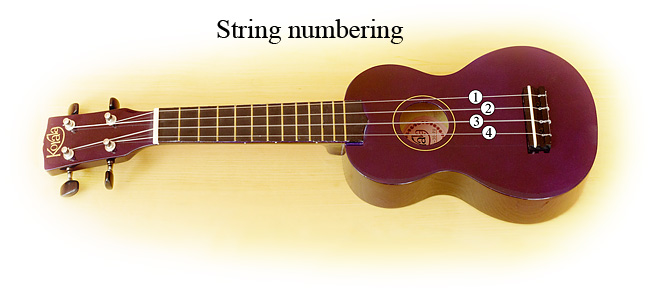Standard Tunings for the Ukulele
For the hurried: The most common tuning is GCEA tuning with a high G string. This tuning can be used for all soprano, concert and tenor ukuleles. Almost all exercises and e-books on this web page were made for GCEA tuning with high G. Therefore, I definitely recommend this tuning for getting started.
String numbering
It’s a strange fact that the strings are numbered in the reverse order compared to the “name” of a tuning. So, for GCEA tuning, the 4th string is tuned to a G, the 3rd is tuned to a C, the 2nd is tuned to an E, and the 1st is tuned to an A. Perhaps it helps a bit to know that this odd string numbering scheme is common for other stringed instruments (like guitars) as well.
 GCEA tuning: string 4 = G, string 3 = C, string 2 = E, string 1 = A
GCEA tuning: string 4 = G, string 3 = C, string 2 = E, string 1 = A
Re-entrant and linear tunings
The most common way of tuning an ukulele — with a high 4th string – is called re-entrant tuning. If you know the guitar, you’d expect that the string with the highest number is tuned to the lowest tone. However, on the ukulele, the 4th string is tuned one octave higher as you’d expect from a “guitar point of view”. This results in an interesting, cheerful sound when strumming the open strings.
The counterpart of re-entrant tuning is linear tuning. This is what we know from the guitar: The common tuning for guitar is linear: The tones of the strings get deeper in the ordering of their numbers.
For the ukulele, the terms high-G or low-G are commonly used to refer to re-entrant GCEA (high-G) or linear GCEA (low-G) tuning. Similarly, high-A refers to re-entrant ADF#B tuning, and so on…
You will often hear that linear tunings (usually low-G) are better suited for solo and melody playing than re-entrant tunings (e.G. high-G), while the latter is best suited for strumming and accompaniment playing. I cannot agree with this opinion. There are lots of interesting techniques and possibilites especially for solo playing, which can be realized only with re-entrant tuning. Besides, re-entrant tuning makes a good part of the charm of the ukulele. If you’re using a linear tuning because you’re “serious” about playing the uke, you’re giving away a large part of its potential. Nevertheless, linear tuning has its own charm with the ukulele, but in my opinion re-entrant tuning is much more interesting and versatile.
The standard tunings
- GCEA: The most common tuning. In my opinion, it’s the best tuning for learning. Well suited for all soprano, concert and tenor ukuleles and widely used. Even some sopraninos can be used with GCEA tuning, and there are special strings which allow GCEA tuning to be used even with bariton ukuleles.
The exact tones for GCEA tuning, respectively for the strings 4, 3, 2, 1:- re-entrant tuning (Standard, High-G): g’ c’ e’ a’
- linear tuning (Low-G): g c’ e’ a’
- ADF#B: (German: ADFisH) This tuning is i.a. very popular in Canada, and was considered the standard tuning for the ukulele in Germany for a long time. By now, in Germany rather the GCEA tuning is preferred. Anyway, the — compared to GCEA — two semitones higher ADF#B tuning is well suited to get more sound out of some sopranos. In addition, the higher pitch can be advantageous, for example when children want to sing along. Although the ADF#B tuning is most commonly used for soprano ukuleles, there are players like James Hill who is using it even for tenor.
The exact tones for ADF#B tuning, respectively for the strings 4, 3, 2, 1:- re-entrant tuning (Standard, High-A): a’ d’ f#’ b’ (German: a’ d’ fis’ h’)
- linar tuning (Low-A): a d’ f#’ b’ (German: a d’ fis’ h’)
- DGBE: (German: DGHE) Standard tuning for the baritone ukulele, usually with low D string, as a linear tuning. This is exactly how the 4 high strings of a guitar are tuned. DGBE tuning can also be used with a tenor ukulele.
The exact tones for DGBE tuning, respectively for the strings 4, 3, 2, 1:- re-entrant tuning (High-D): d’ g b e’ (German: d’ g h e’)
- linear tuning (Standard, Low-D): d g b e’ (German: d g h e’)

 English
English  Deutsch
Deutsch